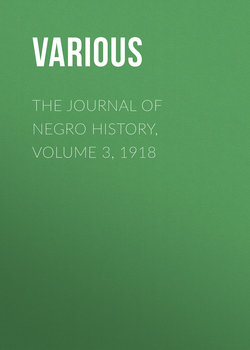The Journal of Negro History, Volume 3, 1918

Реклама. ООО «ЛитРес», ИНН: 7719571260.
Оглавление
Various. The Journal of Negro History, Volume 3, 1918
The Journal of Negro History. Vol. III—January, 1918—No. 1
THE STORY OF JOSIAH HENSON1
ELIZABETH BARRETT BROWNING AND THE NEGRO
PALMARES: THE NEGRO NUMANTIA
SLAVERY IN CALIFORNIA
DOCUMENTS. CALIFORNIA FREEDOM PAPERS41
THOMAS JEFFERSON'S THOUGHTS ON THE NEGRO
I
II
III
IV
V
VI
VII
VIII
IX
X
SOME UNDISTINGUISHED NEGROES
BOOK REVIEWS
NOTES
The Journal of Negro History. Vol. III—April, 1918—No. 2
BENJAMIN BANNEKER, THE NEGRO MATHEMATICIAN AND ASTRONOMER
GEORGE LIELE AND ANDREW BRYAN, PIONEER NEGRO BAPTIST PREACHERS
FIFTY YEARS OF HOWARD UNIVERSITY. Part I204
MORE ABOUT THE HISTORICAL ERRORS OF JAMES FORD RHODES
DOCUMENTS. LETTERS OF GOVERNOR EDWARD COLES BEARING ON THE STRUGGLE OF FREEDOM AND SLAVERY IN ILLINOIS228
SOME UNDISTINGUISHED NEGROES
BOOK REVIEWS
NOTES
Tells of Memorable Day
Measure Sways in Balance
The Journal of Negro History. Vol. III—July, 1918—No. 3
SLAVERY IN KENTUCKY
CHAPTER I. Introduction
CHAPTER II. The Development of Slavery
CHAPTER III. The Legal Status of Slavery
CHAPTER IV. The Social Status of the Slave
CHAPTER V. Public Opinion Regarding Emancipation and Colonization
BOOK REVIEWS
NOTES
The Journal of Negro History. Vol. III—October, 1918—No. 4
THE BEGINNINGS OF THE MISCEGENATION OF THE WHITES AND BLACKS
GERRIT SMITH'S EFFORT IN BEHALF OF THE NEGROES IN NEW YORK
THE BUXTON SETTLEMENT IN CANADA
FIFTY YEARS OF HOWARD UNIVERSITY508. Part II
DOCUMENTS. WHAT THE FRAMERS OF THE FEDERAL CONSTITUTION THOUGHT OF THE NEGRO
SOME UNDISTINGUISHED NEGROES
BOOK REVIEWS
NOTES
Отрывок из книги
No one ever uttered a more forceful truth than Frederika Bremer when she said in speaking to Americans: "The fate of the Negro is the romance of your history." The sketches of heroes showing the life of those once exploited by Christian men must ever be interesting to those who would know the origin and the development of a civilization distinctly American. In no case is this more striking than in that of Josiah Henson, the man who probably was present to Harriet Beecher Stowe's mind when she graphically portrayed slavery in writing "Uncle Tom's Cabin."
Josiah Henson was born June 15, 1789, on a farm in Charles County, Maryland, where his mother was hired out. His parents had six children. The only recollection he had of his father was that of seeing his right ear cut off, his head gashed and his back lacerated, as a result of the cruel punishment inflicted upon him because he had dared to beat the overseer of the plantation for brutally assaulting the slave's wife. Because of becoming morose, disobedient and intractable thereafter, Henson's father was sold to a planter in Alabama and his relatives never heard of him again. His mother was then brought back to the estate of her owner, a Doctor McPherson, who was much kinder to his slaves. Dr. McPherson gave the youth his own name, Josiah, and the family name Henson after Dr. McPherson's uncle, who served in the Revolutionary War. Josiah showed signs of mental and religious development under the pious care of his Christian mother and for that reason became his master's favorite.
.....
When Henson was in England he had the good fortune to exhibit at the World's Fair there some of his beautifully polished walnut lumber, which Mr. Jonas Chickering sent over for him. The only exhibitor of color, he attracted attention from many, among whom was Queen Victoria, who in passing by was saluted by Henson, which salutation was returned. She inquired as to whether the exhibit he had charge of was his work. At the close of the exhibition Henson received a large quarto bound volume describing the exhibits and listing the exhibitors, among whom was found Josiah Henson. In addition he was awarded a bronze medal, a beautiful picture of the Queen and royal family of life size and several other objects of interest.
While in England Henson had the privilege of meeting some of its most distinguished citizens. He introduced himself to the thinkers of the country when, upon hearing an eminent man from Pennsylvania tell the Sabbath-School Union that all classes in the United States indiscriminately enjoyed religious instruction. Henson demanded a hearing and successfully refuted the misrepresentation. Having a standing invitation, he dined alternately with Samuel Morley and George Hitchcock, Esq., of St. Paul's Church Yard. Upon meeting Lord Grey, Henson was asked by the gentleman to go to India to introduce the culture of cotton, promising him an appointment to an office paying a handsome salary. Through Samuel Guerney, Henson had a long interview with the Archbishop of Canterbury, who was so impressed with Henson's bearing and culture that he inquired as to the university from which he was graduated. Henson replied, The University of Adversity. After listening to Henson's experiences for more than an hour he followed him to the door and begged him to come to see him again. He then attended a large picnic of Sabbath-School teachers on the grounds of Lord John Russell, then Prime Minister of England. Sitting down to dinner, Henson was given the seat of honor at the head of the table with such guests as Reverend William Brock, Honorable Samuel M. Peto and Mr. Bess.
.....